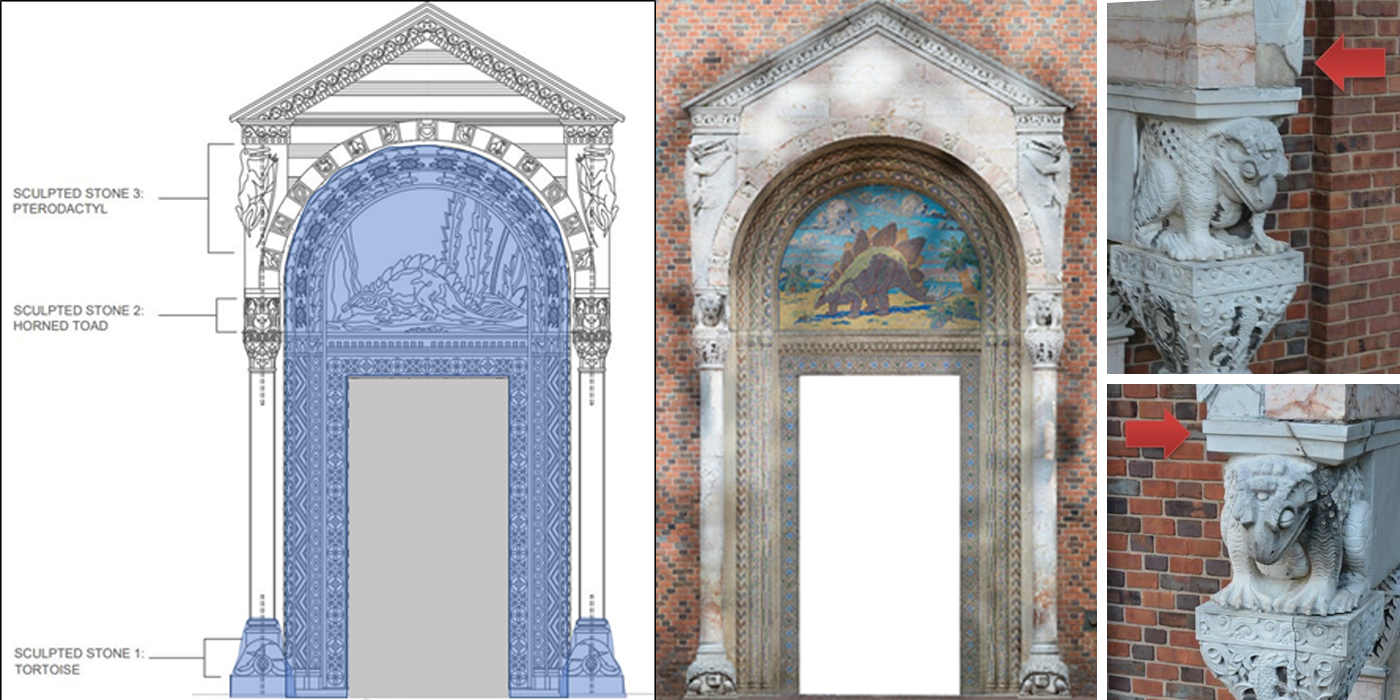Conserving Architectural Heritage: Deconstruction, Storage and Reconstruction of the Reptile House Portico
The Reptile Discovery Center, historically called the Reptile House, was designed by Albert L. Harris, and built in 1931. The Reptile House is one of the most intact historic animal houses at the Smithsonian’s National Zoological Park, which is an historic district listed in the National Register of Historic Places. The Reptile House’s main entrance is through a decorative, shallow projecting stone and mosaic concrete portico featuring carved stone reptiles and a dinosaur mosaic, which hint at the animal exhibits inside.
The goal of this project is to make conditions safe for visitors to the Reptile House, and salvage and preserve as much stone as possible to support the future reconstruction of the portico. Portico reconstruction to match the historic condition will occur in approximately five to ten years as part of future rehabilitation of the Reptile House. Reconstruction will use salvageable historic stone, and new carved stone created from the data gathered from laser scanning documentation.
In response to visible deterioration and repeated patch repairs around and below the pterodactyl figures, the Smithsonian Institution completed a survey and investigation of portico conditions in 2018. Conservation experts examined the portico’s internal structure and traced documentation in the Smithsonian Archives. This study found that the portico’s structure was inadequately loaded as originally built, causing the stone features to crack and deteriorate over time. It recommended that the portico be dismantled and reconstructed with adequate structural support. There was new stone loss and cracking on the portico In the fall of 2019 The same conservation experts returned to assess conditions. In this interim period, conditions deteriorated rapidly, with new stone cracking, breaking off, and new cracks with masonry movement up to 3/8 of an inch.
Conditions at the portico pose significant risks to visitors walking through the primary entrance to the Reptile House and in preserving the historic fabric. In order to align the reconstruction of the portico with planned future rehabilitation work on the Reptile House, the Smithsonian plans to document, dismantle and crate the projecting elements of the portico. High resolution laser scanning of the carved stone elements will assist with re-carving stone elements that are not salvageable. The portico will be catalogued and photographed, carefully dismantled, packaged in collection- quality protective crates, and stored in a covered area at the Smithsonian’s Museum Support Center in Suitland, Maryland.
After the portico dismantling is complete, the Reptile House will have temporary brick infill installed for a finished appearance, and the portions of the portico that are attached to the building will remain, including the dinosaur mosaic. Maintaining the concrete mosaic and some architectural features will maintain a memory of the portico during this interim period.
The Smithsonian has consulted with the District of Columbia State Historic Preservation Office (DC SHPO) on this matter as required by Section 106 of the National Historic Preservation Act, which requires consideration of the effects a project might have on historic properties. The Smithsonian intends to reconstruct the portico to match the historic conditions, and this type of preservation work is normally determined to have “no adverse effect” on historic properties. Due to the long-term storage of the portico elements, consultation with the DC SHPO has determined the potential to result in an “adverse effect” on historic properties. The Smithsonian and the DC SHPO are executing a Memorandum of Agreement (MOA), which is a legally binding commitment for the Smithsonian to restore the portico and maintain the historic integrity of this feature in the future.
As part of consultation, the Smithsonian is soliciting public comment on the deconstruction, storage and reconstruction of the Reptile House portico. Written comments are welcome for a 30-day period closing June 26, 2020, submitted to Carly Bond, Historic Preservation Specialist, at BondC@si.edu.

